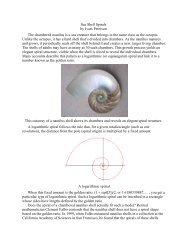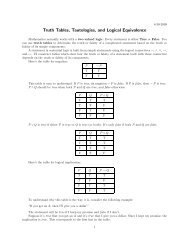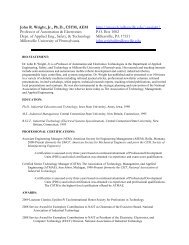Integration by Parts
Integration by Parts
Integration by Parts
Create successful ePaper yourself
Turn your PDF publications into a flip-book with our unique Google optimized e-Paper software.
Differentiate repeatedly down the u-column, and integrate repeatedly down the dv-column. (You don’t write<br />
down the dx; it’s kind of implicitly there in the third column, since you’re integrating.)<br />
How do you get from the table to the messy equation above? Consider the first term on the right: uv.<br />
You get that from the table <strong>by</strong> taking the + sign, taking the u next to it, and then moving “southeast” to<br />
grab the v.<br />
If you compare the table with the equation, you’ll see that you get the rest of the terms on the right<br />
side <strong>by</strong> multiplying terms in the table according to the same pattern:<br />
(+ or −) → (junk)<br />
ց<br />
(stuff)<br />
The table continues downward indefinitely, so how do you stop? If you look at the last messy equation<br />
above and compare it to the table, you can see how to stop: Just integrate all the terms the last row of the<br />
table.<br />
A formal proof that the table represents the algebra can be given using mathematical induction.<br />
You’ll see that in many examples, the process will stop naturally when the derivative column entries<br />
become 0.<br />
<br />
Example. Compute<br />
x 3 e 2x dx.<br />
<strong>Parts</strong> is often useful when you have different kinds of functions in the same integral. Here I have a<br />
power (x 3 ) and and exponential (e 2x ), and this suggests using parts.<br />
I have to “allocate” x 3 e 2x dx between u and dv — remember that dx implicitly goes into dv. I will use<br />
u = x 3 and dv = e 2x dx. Here’s the parts table:<br />
d<br />
dx<br />
<br />
+ x 3 e 2x<br />
− 3x 2<br />
+ 6x<br />
ց<br />
ց<br />
ց<br />
dx<br />
1<br />
2 e2x<br />
1<br />
4 e2x<br />
1<br />
− 6<br />
8 e2x<br />
ց<br />
+ 0 → 1<br />
16 e2x<br />
You can see the derivatives of x 3 in one column and the integrals of e 2x in another. Notice that when I<br />
get a 0, I cut off the computation.<br />
Therefore,<br />
<br />
x 3 e 2x dx = 1<br />
2 x3e 2x − 3<br />
4 x2e 2x + 6<br />
8 xe2x − 6<br />
16 e2x <br />
+<br />
<br />
But 0dx is just 0 (up to an arbitrary constant), so I can write<br />
<br />
0dx.<br />
x 3 e 2x dx = 1<br />
2 x3 e 2x − 3<br />
4 x2 e 2x + 6<br />
8 xe2x − 6<br />
16 e2x +C.<br />
2



![Finale 2009 - [Triplet sequencing]](https://img.yumpu.com/19720079/1/190x245/finale-2009-triplet-sequencing.jpg?quality=85)












